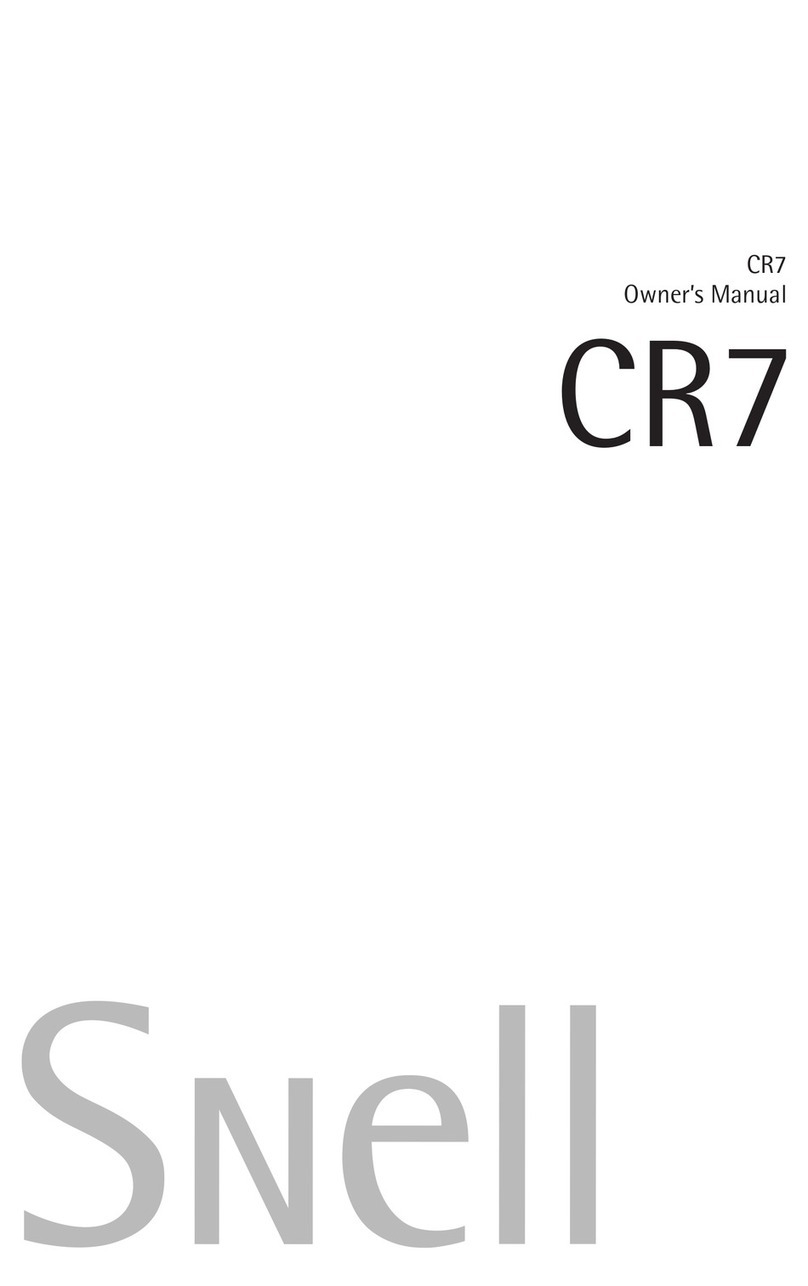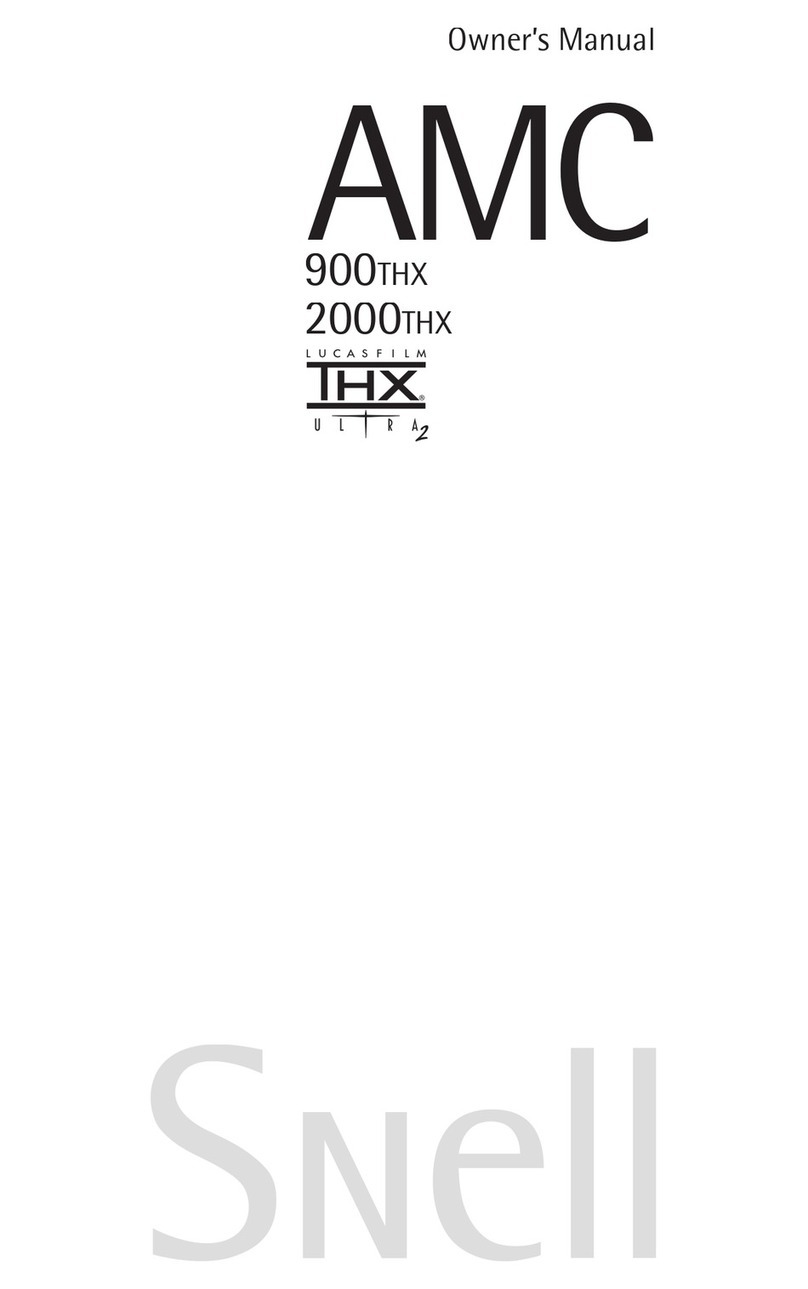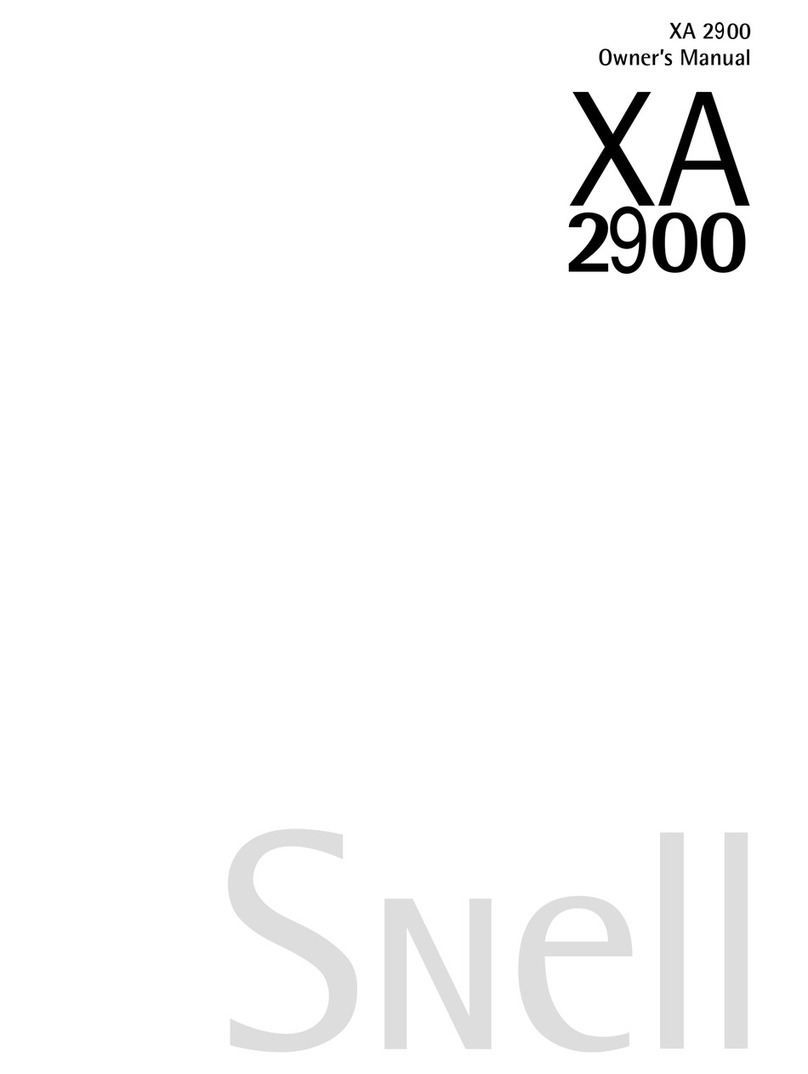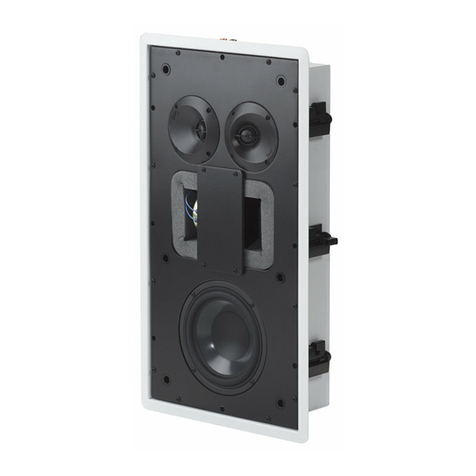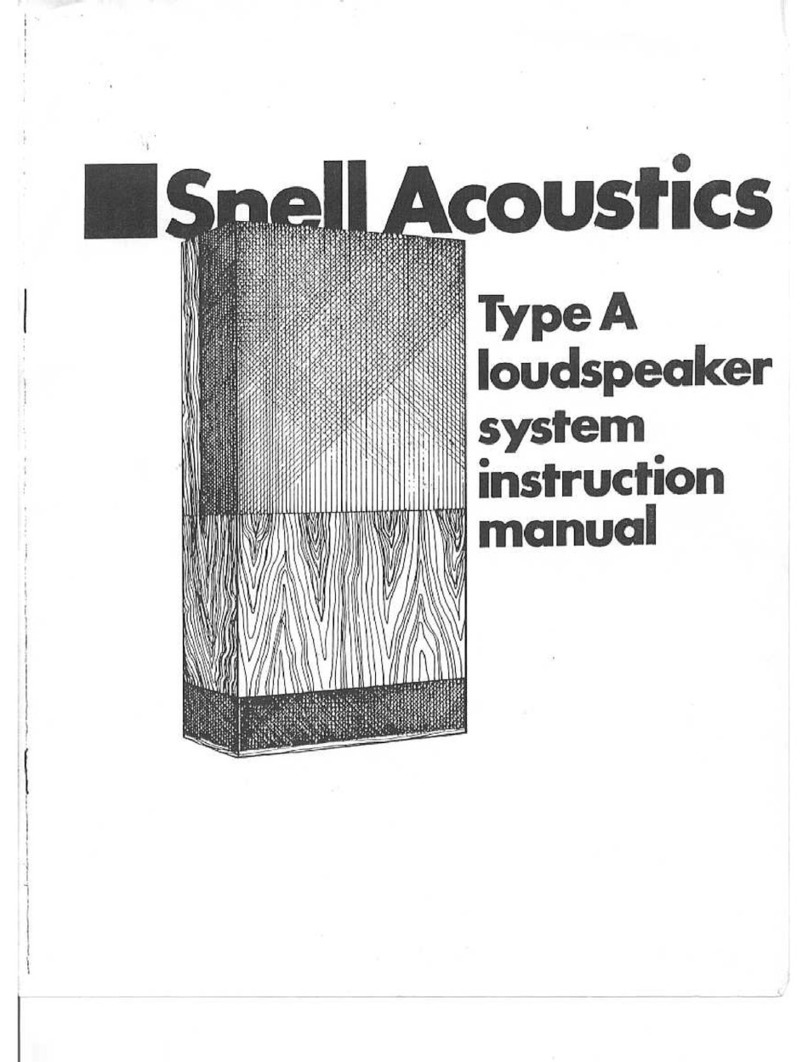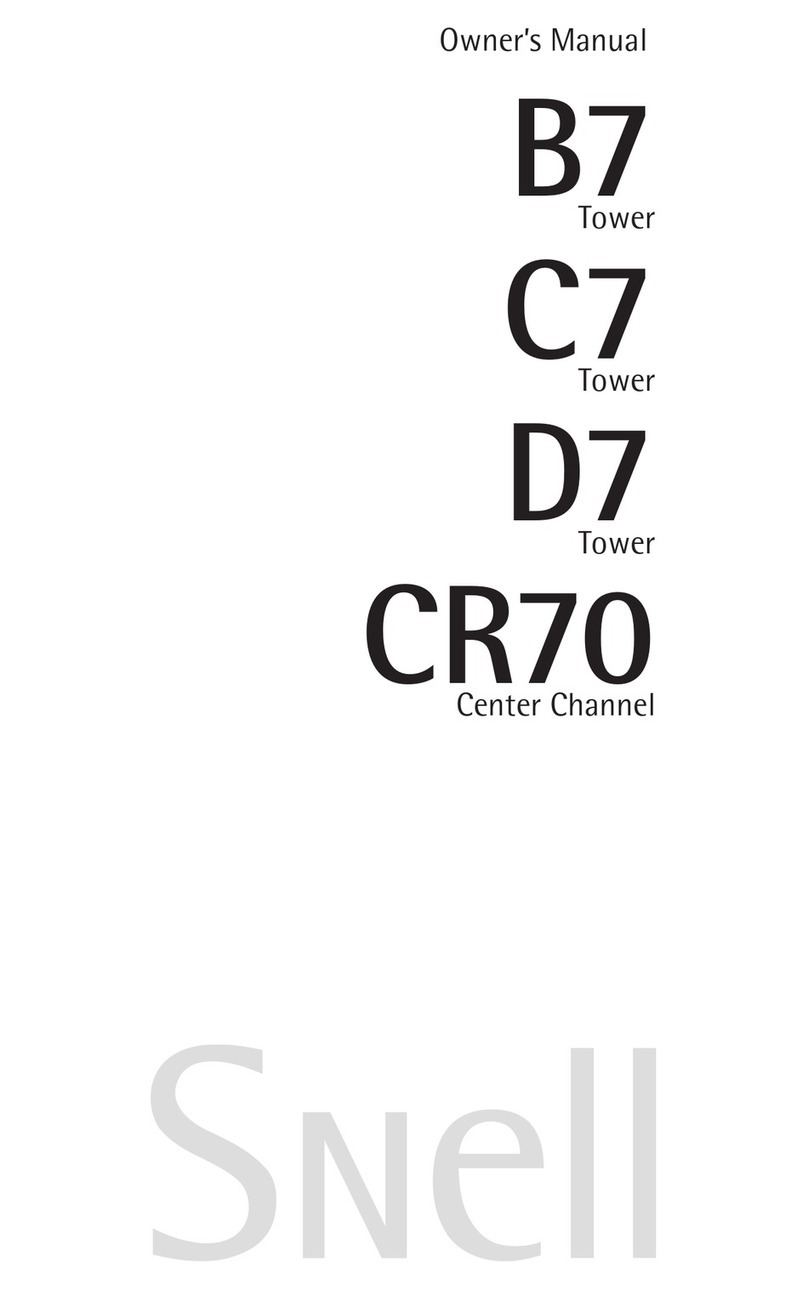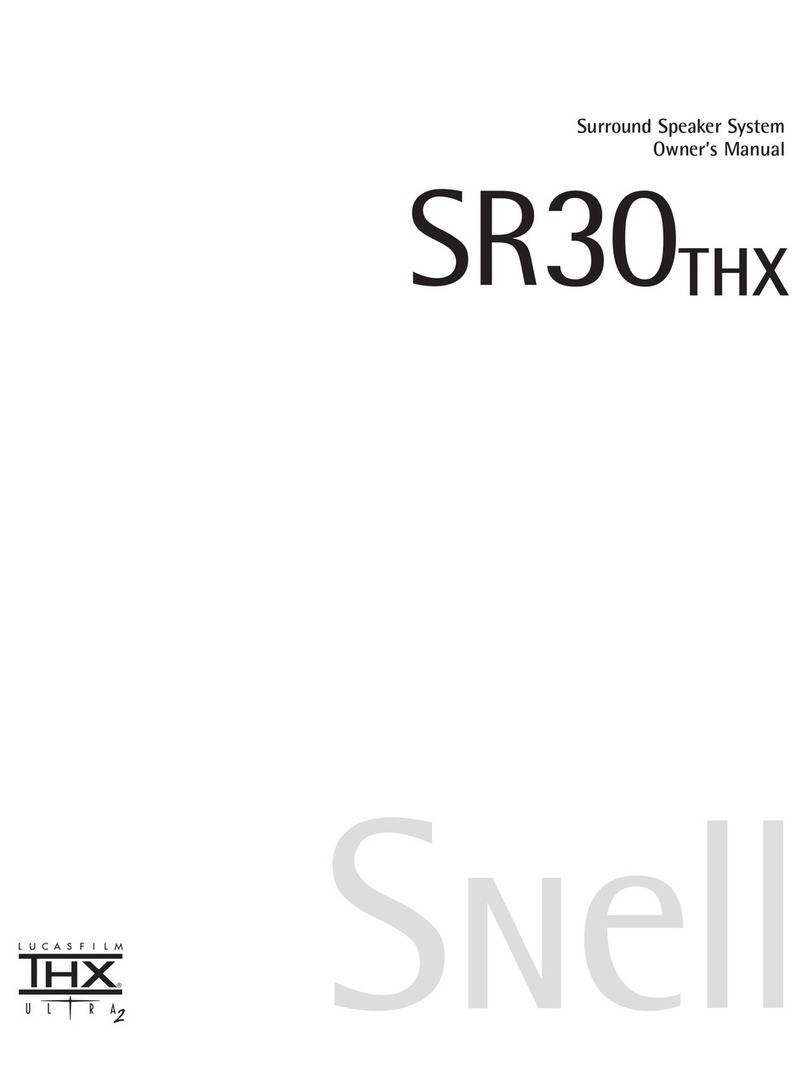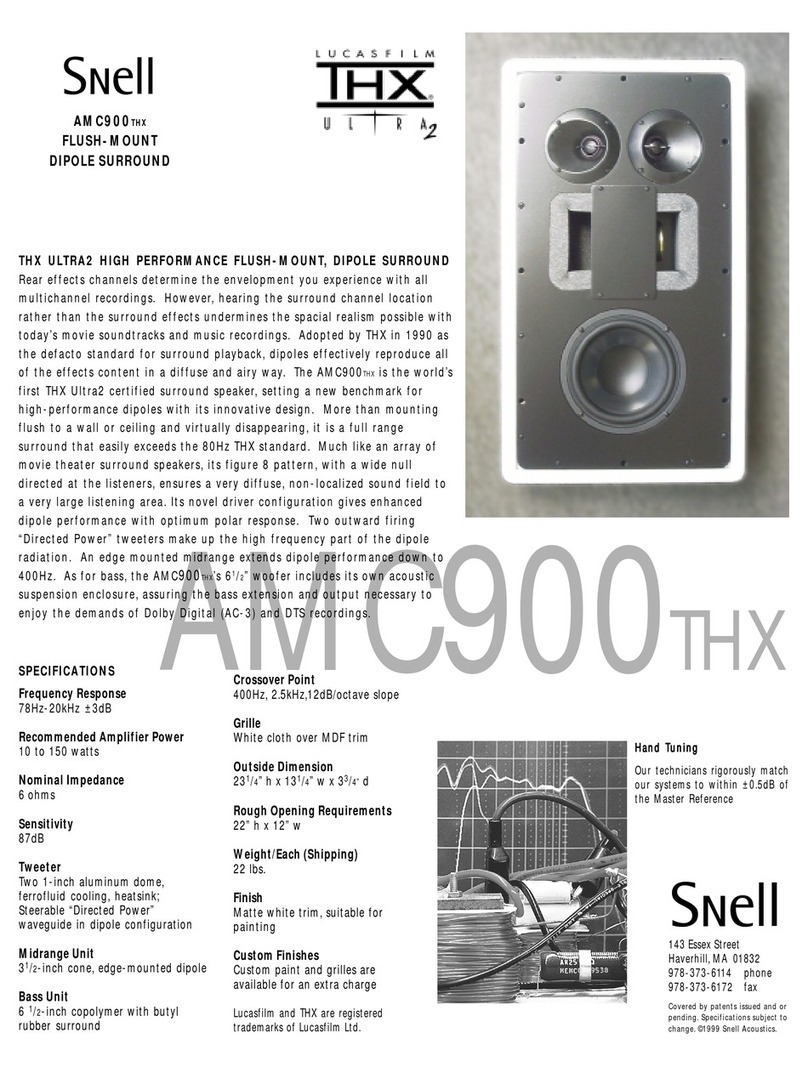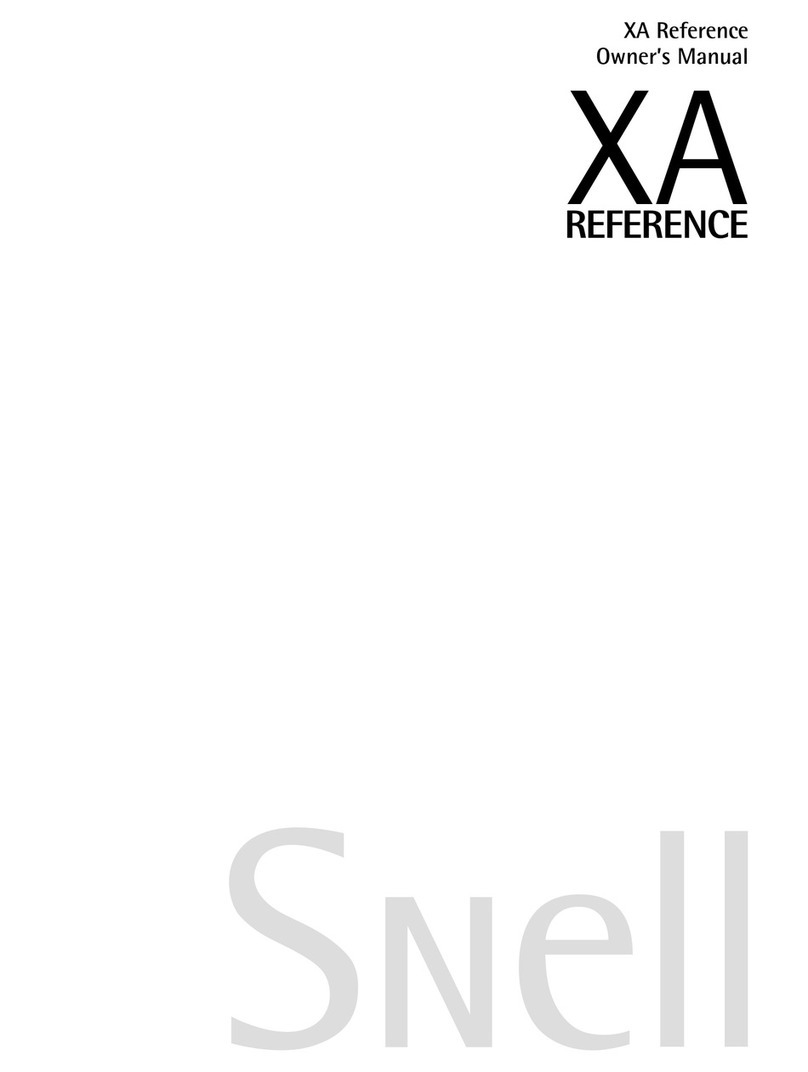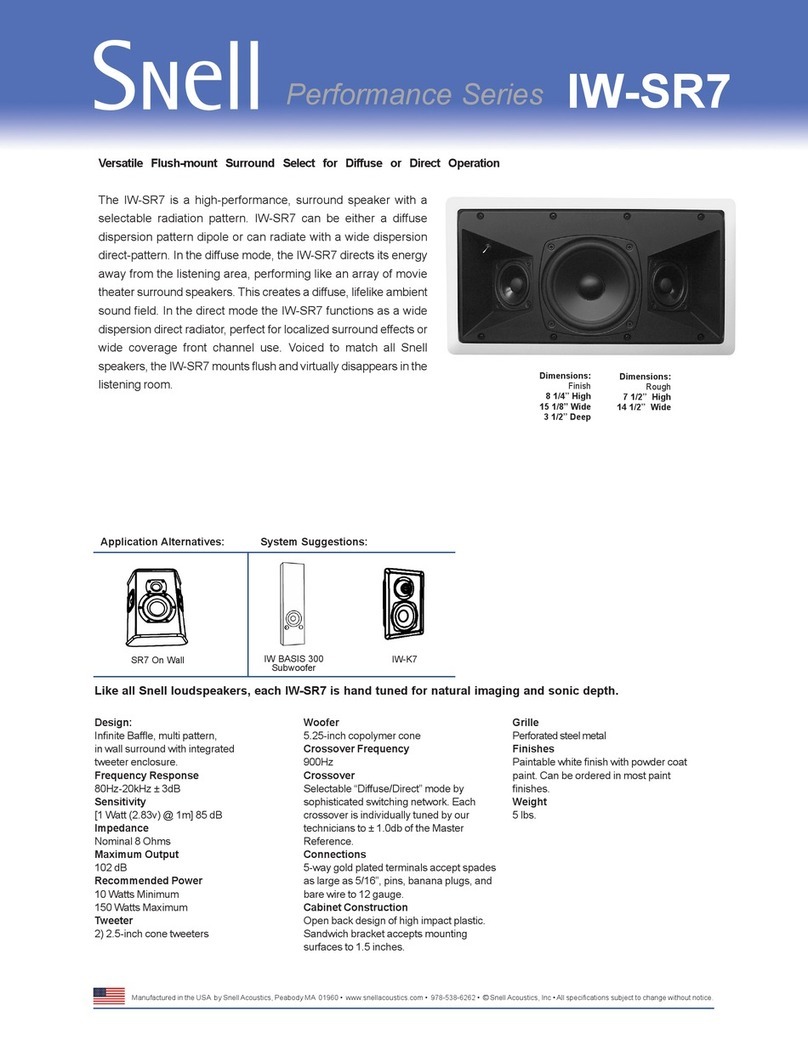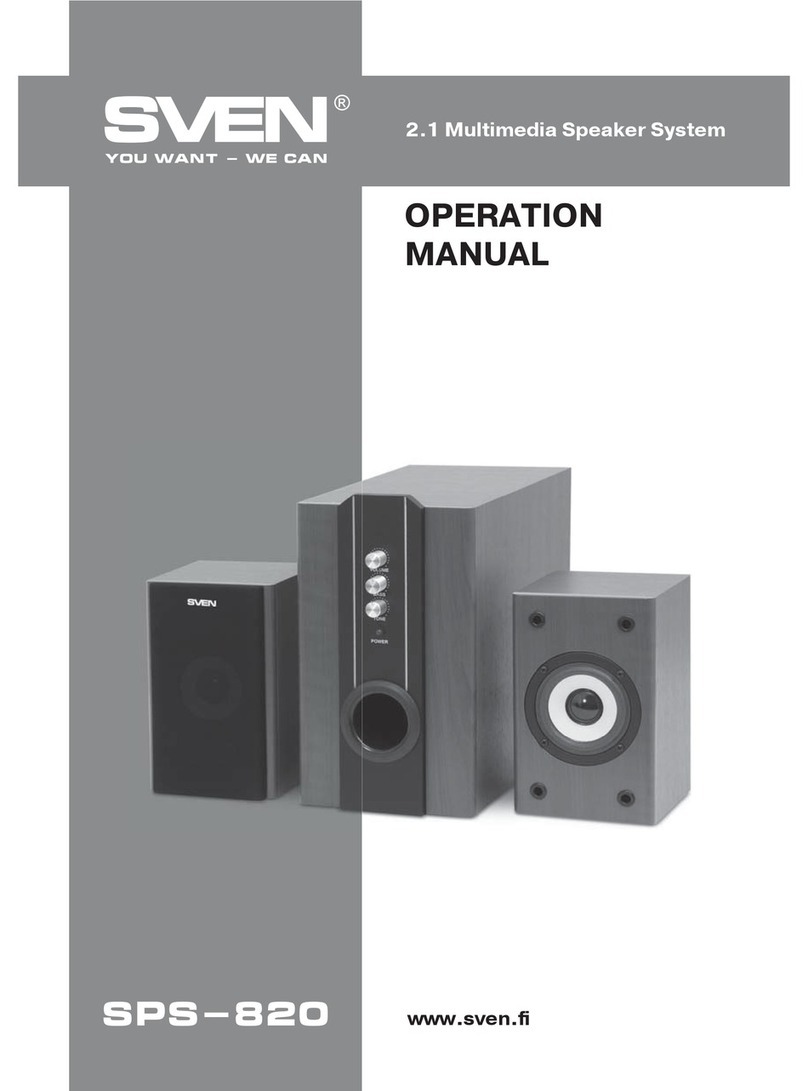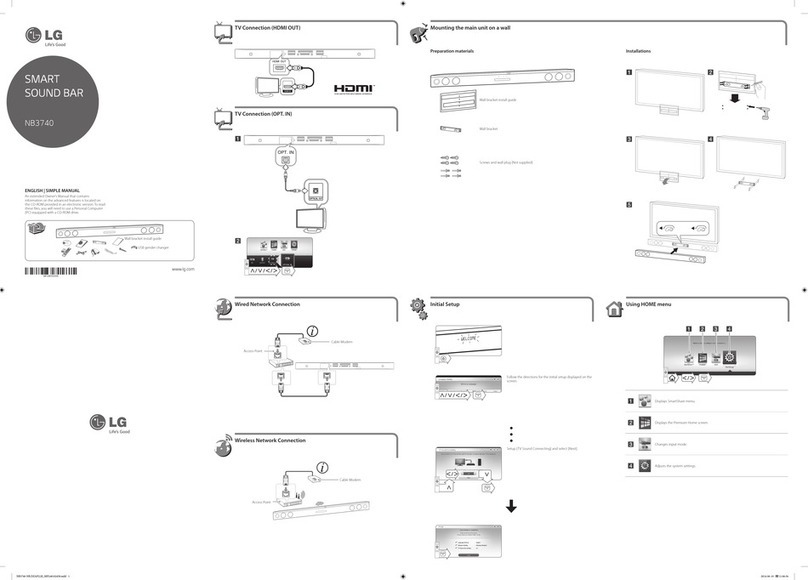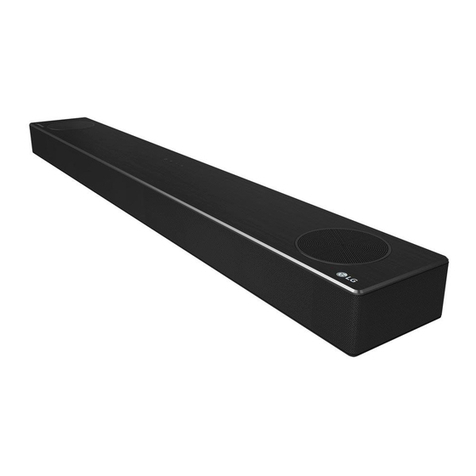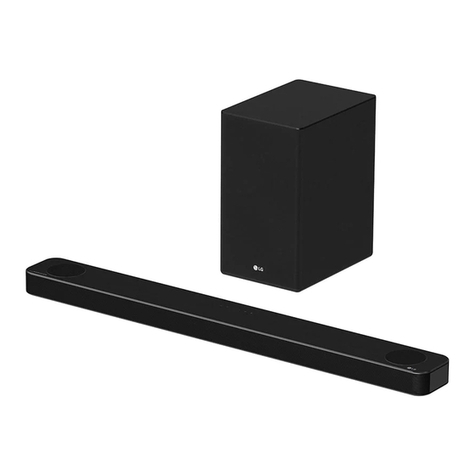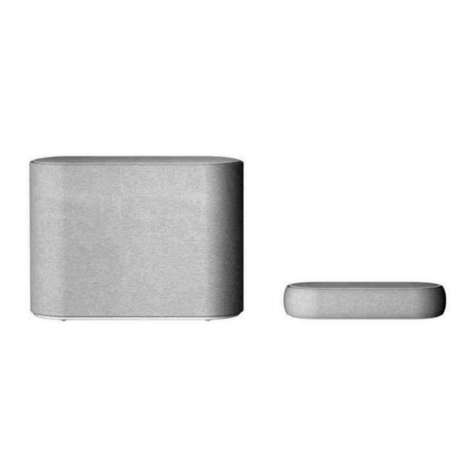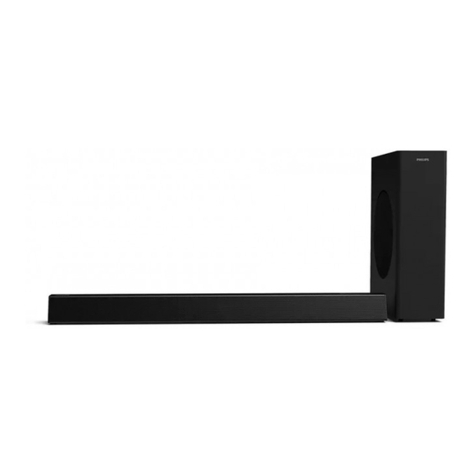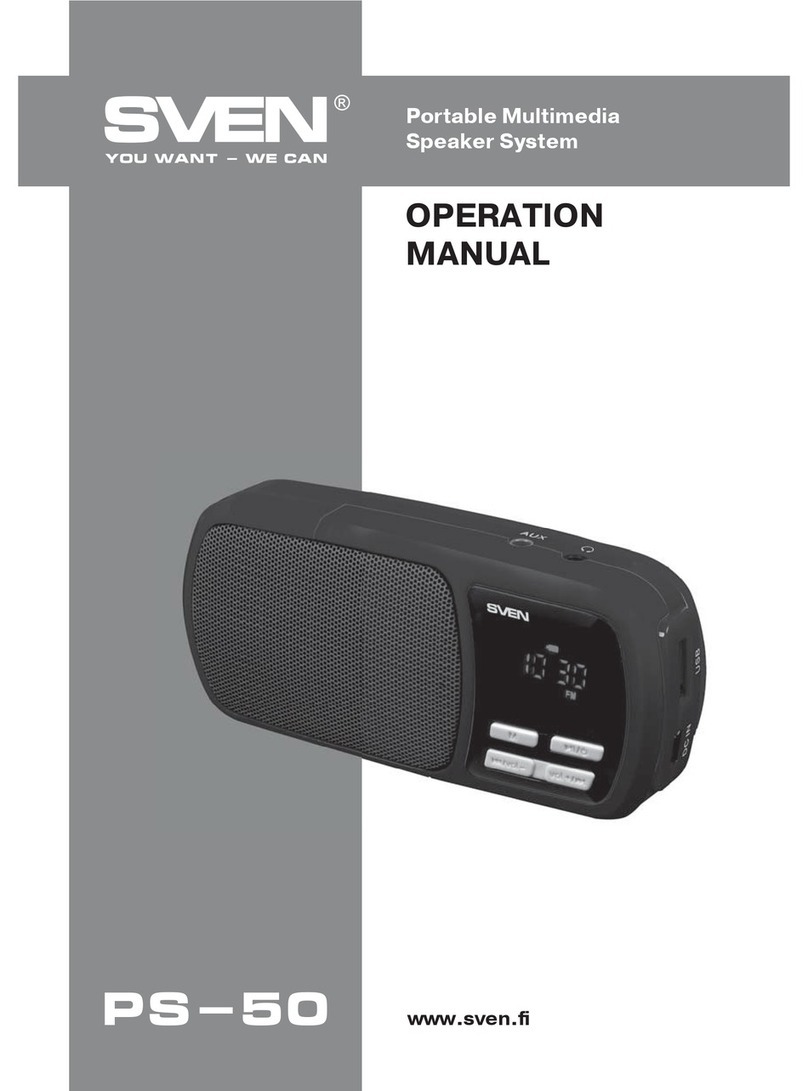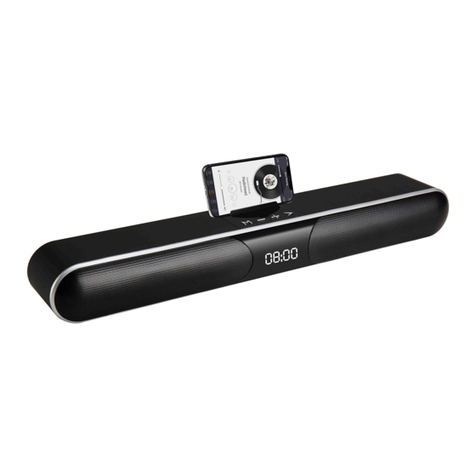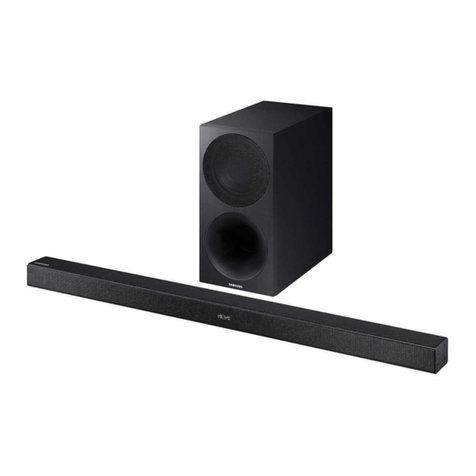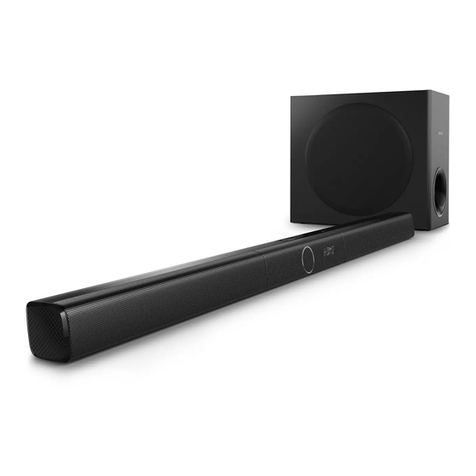Snell Type A User manual

•
,• j
-
1l

Setting Up Your Type A’s
The Type A has been carefully optimized to
give best performance when placed on the floor
and close to one wall. The posilion of Ihe
speakers along the wall, the exael distance from
the wall, and the angle of the speaker with
respect to the listener should be the result of
considerable experimental ion. Generally, Ihe
speakers should form the base vertices of an
Isosceles triangle with the listener at the apex.
In most circumstances Ihe sides should be
slightly longer Ilian the base (distance between
speakers). See figure 1. This may not be possible
in some rooms due to the presence of fire
places. hallways, stairwells or furniture. The dis
tance of the speakers from the corners of the
room will have a pronounced el feet on the
smoothness of the bass response, with the most
natural tonal balance normally occurring when
the speakers are at least several leet from the
corners. Placing Ihe speakers closer to the cor
ners will usually produce excessive bass output,
but if your listening room is lacking in bass, this
location may work successfully. If the speakers
are used near corners, aim them somewhat into
the listening area to minimize the possibility of
strong high frequency reflections from the side
walls of the rooms. In this location, bass
response will be considerably smoother il the
rear woofer ports are partially covered. A heavy
block ol wood set directly behind ihe rear ports
is adequate.
TYPICAL ROOM PLACEMENT
The distance of Ihe speaker's lower section
from the rear wall strongly influences the re
sponse through the upper bass and lower mid
range. Moving Ihe speakers closer to the wall
increases Ihe output in this frequency range. If
positioned carefully, normally seven to nine
inches from the wall, the woofer interacts with
the reflected energy off the wall in a manner
which produces exceptionally smooth response.
Once again, experimentation is called for.
Imaging and high frequency balance are
somewhat affooted by the amount of the "toe-
inVBoth suffer if the listening position is more
than 35° off-axis. The ideal amount of toe-in is
also room dependent, since rooms vary in
liveness and brightness. Ten to twenty degrees
off-axis works optimally in many rooms. Alter
natively. placing the speakers parallel to Ihe rear
wall is sometimes effective.
The listening "window" of the Type A is ex
tremely wide, and although best listening will be
attained at the apox of the Imaginary isosceles
triangle, there is a much larger listening area
where the imaging and tonal balance remain
excellent.
One situation which should always be
avoided is the placement of tall objects in front
of or to the sides of Ihe Type A's. This will result
in reflections which will affect imaging and
detail Several feel of free space will amply re
ward the listener with smoother, more accurate
reproduction of complex musical passages.
Note that Ihe speakers are labeled
"lulT'and "right". They are produced in mirror
image pairs, with Ihe left speakers having slight
ly better dispersion towards the right (when fac
ing the loudspeaker) and vice versa. When posi
tioning Ihe speakers along Ihe same wall with
their fronts facing the listener, the "left"
speaker should be to the loll of Ihe "right"
speaker.
The speaker should stand vertically. If Ihe
lloor lilts away from the wall, prop up Ihe fron!
edge of the woofer cabinet until the speaker is
vertical.
The dispersion of Ihe loudspeaker allows for
a placement which would be impossible for most
loudspeakers but works well with the 1'ype A in
certain rooms. The speakers may be placed on
opposite walls, slightly toed-in so I hat Ihe lis
tener is not much more than 25° off axis. See
figure 2. The normal orientation of the left and
right loudspeakers should bo reversed (so that
the left speakci is on the right and vice versa).
The usual cautions about corner placement
should be kepi in mind. Imaging may often be
improved in difficult rooms, but bass perfor
mance may sometimes suffer.
How?
The Type A consists of a bottom section,
containing tfie woofer, an upper section, con
taining the midrange and tweeter, and a jumper
cable connecting the two halves.

If the speaker is lo be placed on a hard
floor, apply the enclosed fell disks to the under
side of each bottom section.
Place a lower section In the first position
that you have decided to try. Fit the upper sec
tion on the lower, lining up the pegs with the
holes. If yon are not bi-amplifying, connect the
jumper cable between the jacks marked “to
woofer" on the upper section to the jacks marked
“woofer input” on the lower section, checking
that the red striped pin o( the plugs are inserted
in the red jacks. See figure 3. Make sure that a
shorting plug is inserted in the jack in the bottom
section labeled “Short for normal mode“. II Ihe
speaker is to be bi-amplified, refer to Ihe section
on bi-amplification below.
Repeal Ihe process with the oilier speaker.
The connectors at the rear of the top sec-
lions marked “input 4 ohms" will accept bare
wire, spade lugs or various “double" banana
connectors such as the Pomona MDP, Ihe
banana connectors having the advantage of
easiest connection arid removal.
The length and type of speaker cable used
in your system will have an audible effect. Under
no circumstances should 'wire of gauge higher
(thinner) than /Mb be used. In general, the longer
the lenglh used, the greater the necessity of a
lower gauge, and the lower Ihe gauge, the better
Ihe sound, with diminishing returns setting in
around #10 or #12«
A variety of speaker cables are now avail
able whose manufacturers claim better perfor
mance than with standard heavy gauge wire. We
have verified this in some cases, and the im
provements available are ollen more noticeable
than the differences between wires of different
gauge. The differences vary with Ihe amplifier
and speakers used, and il should be noted that
some can damage some amplifiers.
We would also recommend, if possible, that
short runs of speaker cable connect the power
amplifier(s) and speakers and that long inter
connect cables of high quality be used to con
nect the preamplifier and power amplifier. This
of course results in the power amplifiers being
close to the speakers, which may be practically
or cosmetically difficult, but if the lenglh of Ihe
speaker cables can be reduced to a few meters,
sonic advantages may be obtained. The effects
of cables may somelimes be masked il the
equipment is not of the highest quality
Your Typo A's should be wired in phase with
each other. All speaker cables are marked so that
it is possible to distinguish between strands by
color of wire or insulation or by a white stripe or
raised ridge along one strand. H vou are using
one stereo power amplifier (or two mono ampli
tiers) as opposed lo bi-amplifying, conned one
strand to the left channel of your amplifier's
black (or ground) terminal and Ihe other end of
that strand to the black terminal on Ihe rear of
your lull Type A marked “input 4 ohms". Connect
the other strand of that cable lo the other termi
nal (usually red) on the left channel of your
amplifier and to the red terminal on your left
speaker. Connect the other cable between the
right channel on your amplifier and the right
loudspeaker in exactly the same fashion. Should
you be interested in the absolute phase of your
system, a positive voltage at Ihe red terminal on
the Type A will cause all drivers tu move
outward.
Very tight and positive connections are
necessary. If you are using a heavy gauge wire be
careful that as much as possible comes in contact
with the amplifier and speaker terminals.
Save the boxes and all packing, including the
plastic bags. If the speaker should evei require
repair, they will need to he shipped lo the factory
in 1 heir original cartons, using all the packing, or
serious damage will he likely.
Associated Equipment: Proper Selection
and Use
The extraordinary accuracy and transparency
of the Type A allows il to fully reveal Ihe strengths
and weaknesses of the associated audio equip
ment and source material. While the Typo A will
bring to life the sonic delights of state-of-the-art
components, it will with equal clarity bring out any
system flaws. This does not mean that expensive
equipment is a prerequisite to good sound from
the Type A, but rather that Hie equipment must be
wisely selected, and setup with care. The rewards
will be well worth Ihe effort
The phono cartridge is second only to tho
speaker in the extent of its effect on the sound of
Ihe system. The alignment of the cartridge is ex-
tremcly critical. Many of the protractors and guides
supplied by turntable and arm manufacturers are
inadequate or incorrect. Consult your dealer for a
chart relating proper overhang, of (set angle and
the pivot to stylus distance of your arm. Experi
ment with vertical tracking angle and lone arm
damping. Tone arm-cartridge compatibility will
also affect the results you obtain.
Tfie low frequency response of tfie Type A
allows turntable rumble to be mercilessly revealed.
Audible rumble in your turntable (not recorded in
the source) should not be tolerated.
Record warps are reproduced in an audio sys
tem as extreme low frequency Vibrations which
will occasionally overtax a power amplifier or
damage a woofer. If you must play a severely
warped record, Ihe use of a subsonic filler is re
commended. although I hey are not usually sw Ili-
ciently sleep so as to eliminate the problem. Under
other circumstances the audible effects of almost
all subsonic filters make their use inadvisable in a
good system.
A turntable should not be placed so near to
the Type A that vibrations are passed back through

WIRING HOOKUP FOR NORMAL OPERATION
FIG. 3
air or floor lo Ihe turntable, causing feedback.
Feedback can result in deterioration of the sound
long before the familiar "howling" is evidenced. A
good lest to find the susceptibility of your system
to feedback follows: Place the stylus on a record
as if to play it but leave the turntable off. Turn the
volume control up to a position appropi iate to loud
listening Lightly tap shelf on which your turntable
is resting. If no sound is heard through the
speakers, all is well. If a dull tapping is heard
through your speakers, your suspension is not
perfect. If Ihe sound reverberates after the tap for
a fraction of a second or longer, you are on the
threshold of feedback. Consult with your dealer
as to the best way of eliminating feedback in your
system. The best solution is more typically mov
ing the turntable, using a sub-base, and/or sus
pending the turntable from a wall or from the
celling.
The use of tone controls and equalizers
should be tempered with moderation. In general,
the less signal processors in the signal path the
better, but it Is a sad fact that nearly all modern
recordings are mixed down and equalized using
"monitors" less accurate than your Type A's. With
flawed recordings it may be useful to employ an
equalizer or tone controls, l-xcessivu boost of
any frequency may damage your system.
Preamplifiers and moving coil step-up devices
vary widely in sound quality and should be audi
tioned and compared if possible.

The question of amplifier power is not easily
«answered without reference to a particular listen
ing environment. Less than fifty watts per channel
Into 4 ohms will rarely provide sufficient power to
provide optimum performance in an average room,
and two hundred watts may sometimes be inade
quate in a largo/oom at very high levels. The Type
A can comfortably handle many hundreds of watts
of clean power on good source material with no
signs of strain. For the widest possible dynamic
range, bi-ampliflcation is recommended. On the
other hand, an improperly used 50 watts per chan
nel amplifier can possibly be överdriver» into
damaging your Type A's. Turn-on transients, the
disconnection of audio cables during the use of
the system and acoustic feedback can cause
damage. Volume controls should be set close to
the minimum when tone arms are cued or radio
stations are tuned, as these may produce dan
gerous transients as well.
Fuses
Every driver on thp Type A Is individually
fused. These fuses will protect the Type A from
most forms of abuse but are not infallible. If a fuse
blows, Ihe driver which it protects will cease to
operate and the speaker will evidence a severe
lack of bass, midrange or treble.
Fuses should be replaced with the exaqt value
and type supplied. Use of slow blow fuses or val
ues higher than those recommended will Invali
date the warranty.
Woof or 3 arnpcro (Buss AGC 3 of Utlolfyse 3AG 3A)
MidrnnQG 2V> ompore (Buss AGC 2V> of lltlnliuae 3AG 2'/»A)
Twenler 2 ampere (Buss AGC 2 or Littnltiise 3AG 2A>
If a fuse blows, the speaker has been sub
jected to excessively higtj power levels, and the
volume should be reduced somewhat. If a fuse
continues to blow at lower volume settings, check
the condition of your electronics.
Problems
If your audio system Is malfunctioning, check
the speaker's fuses, the jumper cable, and the
connections at the speaker’s input. If one of the
three fuses Is blown, it will produce a very notice
able lack of bass, midrange, or treble. See the
section on fuses.
If only one channel Is malfunctioning, you
can determine If It is the speaker or If it is else
where in the audio system by switching the input
wire from the back of speaker A to speaker B and
vice versa. If the same speaker still sounds faulty,
it is most likely the source of the trouble. Alter
natively. if it Is hard to switch the wires between
speakers, you can make the exchange between
channels at the back of the amplifier. If the same
speaker sounds faulty, then it is likely that either
the cable connecting your speaker and amplifier
or your speaker Itself is at fault.
If your system sounds faulty but you are un
able to pin down the source of the diffuclty, go to
your dealer for advice. Do not assume that It Is
necessarily your speakers which are at fault. For
example, your stylus may be worn or defective.
Do not return your speakers to the factory
for repairs without prior consultation with your
dealer or with the factory, All repairs are done
at the factory to Insure that the speakers are
performing to specifications. If a speaker mu9t
be returned for repairs, pack it carefully, referring
to the packing diagram at the back of the man
ual and using all packing material, including the
plastic bag.
The speaker grilles are not user-removabla.
Repairs of the Type A by the owner or dealer
may invalidate the warranty.
Caring For The Finish
The Type A Is handcrafted from the finest
materials. An occasional (perhaps once a year)
thin coat of dark paste wax (clear paste wax for
the oak cabinets) will preserve the beauty of the
finish. Using a paper towel, apply a very liberal
coat of the wax, then wipe off Immediately and
buff thoroughly. Do this to one surface at a time.
Be careful that wax does not get onto the grill,e
material. In this regard, it may be helpful to place
a long strip of stiff paper edgewise Into the
space between the cabinet and grille. Rubbing
alcohol will remove wax from the cloth.
Bi-Ampllflcation
Why?
Bl-ampllfylng the Type A can result In a sub
stantial Improvement In sound quality. To under
stand why this Is possible, consider the normal
versus bl-ampllfled setup.
In the normal, unbl-ampllfled mode the right
and left signals pass from preamplifier to loud
speakers unchanged except for amplitude. Inside
each speaker the Internal crossover divides the
signal Into the midrange and high frequencies
reproduced by the upper sections and the low
frequencies handled by the bottoms. In the bl-
ampllfled mode, shown In figure 4, the right and
left signals are divided after the preamplifier by
the electronic crossover Into high and low fre
quency signals. One stereo power amplifier then
amplifies the highs (both channels) and the other
stereo power amplifies the lows. The highs are
sent Into the upper sections of the Type A's,
where they pass through the midrange and
twoeter crossovers, though bypassing the mid
range's low frequency roll off, and on to the mid
range and tweeter drivers. Similarly, the lows go
to the woofers, by passing the Internal crossovers.

This configuration has several advantages.
Each amplifier is dealing with frequencies in a
restricted range, thus it cannot combine high
and low frequency signals and produce sum and
difference by-products (intermodulation distor
tion. or IM). If very high power Is needed to re
produce the sound of a kickdrum, the demand
for low frequency power will not affect the ability
of the high frequency amplifier to perform nor
mally, whereas il all frequencies were repro
duced by the same amplifier its power supply
might be temporarily depleted, causing dynamic
compression or clipping of the high frequency
material. The advantage is similar to that of the
"dual monaural" amplifier design with totally
separate channels and the elimination of so-
called "dynamic crosstalk".
If one is not fortunate enough to choose an
amplifier without regard for cost, bi-amplification
allows the owner of Type A’s the ability to match
an amplifier to the frequency range (high or low)
il is most comfortable with.
The power requirements of the upper section
are slightly less than that of the lower section
so a higher quality smaller power amplifier may
often be used.
Note, however, that bi-amplification will not
mask the audible effects of a substandard am
plifier; it may even exacerbate the problem. Do
not use amplifiers of widely varying sound
quality. Do not use an amplifier having signifi
cantly less power than would be used if not hi-
amplifying.
Since only low frequencies are being sent
to the lower sections in the bi-amp mode, the
Type A is designed so that the Internal woofer
crossover is bypassed, resulting In closer coup
ling of the amplifier and woofer and increased
damping.
Overall, the improvements from bi-amplifica
tion can bo described as greatly Improved bass
impact, a more "relaxed" and dynamic high end,
and increased openness throughout the audible
frequency range.
How?
In figure 4 one sees that a Snell Acoustics
Electronic Crossover*, an extra stereo power
amplifier, and additional speaker cables and
"phono" cables are needed for bi-amplification.
If at all possible, we would suggest that the
dealer from whom you purchased the loud
speakers should do the initial set-up. If not. a
signal generator, also known as an audio oscil
lator, and a VOM may be needed for set-up.
SYSTEM WIRING FOR BI-AMPLIFICATION
POWER AMPLIFIER
FIG. 4
*Thn electronic crossover
must
have the appropriate cross
over characteristics, otherwise the sound will nut be opti
mum and damage tu tiro speaker may occur.

Tu start, one? must establish whether the
power ampliliers involved are inverting or non-
inverting, that is, do they leave a sine wave un
changed except lor amplitude or do they invert
it (turn it 180° out of phase). If you are using two
identical ampliliers in your system to power the
upper and lower sections of the Type A's, it is
likely that they are both either inverting or non-
inverting. Some amplifier manufacturers have
introduced changes in their amplifier’s circuitry
that reverse this, however, so that Iwo seemingly
Identical amplifiers built at different times may
differ. The amplifiers can be tcsled as below or
the manufacturer can be contacted with serial
numbers. Incidentally, there is no advantage
attached to an amplifier being of an inverting ur
non-inverting nature, but d the two amplifiers
used in bl-arnplng differ in this regard, the upper
and lower sections of the Type A 'will be out of
phase. The speaker wiring rnusl then be changed
lo correct the phase, as will be discussed below.
The easiest way to ascertain whether both
amplifiers fall into the same category is to hook
one channel of one amplifier to the left loud
speaker and a channel of the second amplifier
lo the right loudspeaker (normal set-up. except
for amplifiers). Place the speakers side by side,
switch the preamp lo monaural, and adjust the
preamp balance control until the two speakers
are of roughly equal loudness. While listening lo
music with substantial bass information, reverse
the speaker leads at the input ol one loud
speaker. The apparent bass output ot the pair of
loudspeakers will either inciease or decrease.
The speakers will be "seeing" the same signal
when the bass is loudest II this occurs with (lie
leads unreversed, the amplifiers are alike with
respect to inversion of the signal If the bass is
loudest wilh the leads reversed, llte amplifiers
are different. I'his information will be used in the
next stage of the sel-up.
We are now ready lo connect the two power
amplifiers to the loudspeakers as shown in figure
5. If you are converting from a single amplifier
set-up. disconnect the jumper cables that nor
malty interconnect the upper and lower sections.
Next, transfer the shorting plug on the lower
sections from the “Short for normal mode" jack
to Ihe “Short for biamp mode" jack. Add a short
ing plug lo I he “hiamp mode" jack on the upper
sections.* If you do not have an additional short
ing plug, one can be readily assembled from a
standard double banana plug and a short length
of heavy wire. Finally, connect Iho outputs ol the
high frequency amplifier to the jacks marked
“input 4 ohms" on the upper sections, and the
outputs of the low frequency amplifier to the
jacks marked "woofei input" un Ihn lower sec
tions. using speaker cables ol good quality. If
the inverting test showed the amps to he dis
similar, reverse the hoi and ground connections
at the input of both upper sections.
We now proceed to Ihe liuok up of the elec
tronic crossover (figure 4). The main outputs of
the preamplifier should be fed to Ihe inputs of
the electronic crossover. The high frequency
outputs ol the crossover should be connected lo
Ihe respective channels ol Ihe high frequency
power amplifier and the low frequency outputs
should be connected to the respective channels
ol the low frequency power amplifier.
At this point we must make level adjust
ments on the crossover lo compensate lor Ihe
differences in gain between different power
amplifiers. One power amplifier may multiply the
signal fed to it from the crossover by a factor of
30. another by a factor of 40. This is unrelated to
the rated power ol the amplifier, which is Hie
maximum amount ol power Ural Ihe amplifier is
capable of producing. An amplifier with higher
gain would send a louder signal to the section
of the Type A tfiat it powers than an amplifier
with lower gain; thus using amplifiers with dif
ferent gains in a bi-amp setup would result in an
imbalance between upper and lower sections of
the Type A's. This is corrected by adjusting the
high and low frequency level controls on the
electronic crossover. Those level controls rnusl
be set very precisely, following Ihe procedure
outlined below, using a signal generator and
VOM of high quality. Refer to Figuie 6.
Connect Ihe signal generator lo an auxiliary
input of Ihe preamplifier, pul tire preamp into
monaural mode, and set Ihe tone controls to flat.
Turn all the level controls on the electronic
crossover lo their maximum positions, but leave
(tie preamplifier volume control fully down.
Select a 4000 Hz tone on the signal generator
and conned Ihe probes ol the VOM to the left
channel high frequency power ampliliei output
terminals. Slowly turn up the preamplifier volume
control {and the signal generator volume control
if necessary) until the VOM reads exactly 1.5
volts. Now connect the VOM probes to the tell
channel output terminals of the low frequency
power amplifier and select a 40 Hz lone on the
signal generator. If the VOM reads greater than
1.5 volts, reduce the left low frequency level
control on the crossover to give a 1.5 volt read
ing. being careful not to change the* position of
lire preamplifier or signal generator volume con
trols. If the 40 Hz VOM reading was Initially less
Ilian 1.5 volts the preamp volume control must
be increased until 1.5 volts is reached. This will
ol course increase the high frequency output as
well, so you must once again select 4000 Hz arid
reduce Ihe high frequency level on the crossover
until the high frequency power amplifier VOM
reading is back down lo 1.5 volts. Once again
take a low frequency power amplifier reading at
40 Hz and a high frequency power amplifier read
ing at 4000 Hz lo double check that both read
1.5 volts un Iho VOM Finally, repeal Ihe onlim
procedure for the right channel.
’WARNING: Never connect Hit* shorliny plug lo Ihr? upper
section "bianip mode" lack unless using an clechomn ciosr,
over which has Ihe correct crossover spocHiealions and is
approved by Snell Acoustics. Damage rosulling Irani Ihe
above conslilnles misuse mid may void ihe vmrumly

The system should now be operational
I isten to a record or tape that you are familiar
with, using the balance control on the pre
amplifier to listen lo each speaker separately
and checking that each speaker is working in
dependently and that upper and lower sections
of both speakers are producing sound. The
speakers are now correctly bi-amplified.
WIRING HOOKUP FOR BI-AMPLIFICATION
FIG. 5

ELECTRONIC CROSSOVER LEVEL ADJUSTMENTS
(left charnel shown)

SPECIFICATIONS
Frequency response on axis
and up to 25 degrees off axis*
36 Hz to 18 kHz ± t x db
Impedance (minimum) 4 ohms
Power requirements (minimum) • 80 watts RMS/channel
Driver complement 10-inch (24.5-cm) woofer
4-inch (10.2-crn) midrange
1-inch (2.54-cm) tweeter
Crossover frequencies 275 Hz and 2500 Hz
Fusing
Woofer
Midrange
Tweeter
AGC 3 or 3AG 3A
AGC 2Vi or 3AG 2»/?A
AGC 2 or 3AG 2A
Dimensions
Upper section
Lower section
25.5” high x 23.75" wide x 13.0" deep
(64.8 x 60.3 x 33.0 cm)
21.0" high x 23.75" wide x 13.0" deep
(53.3 x 60.3 x 33.0 cm)
Weight
Upper section
Lower section
43 pounds (19.5 kg)
54 pounds (24.5 kg)
•This rating applies to the inner side. The speakers are mirror image pairs, having slightly better dis
persion toward the inner side.
Other manuals for Type A
1
Table of contents
Other Snell Speakers System manuals
